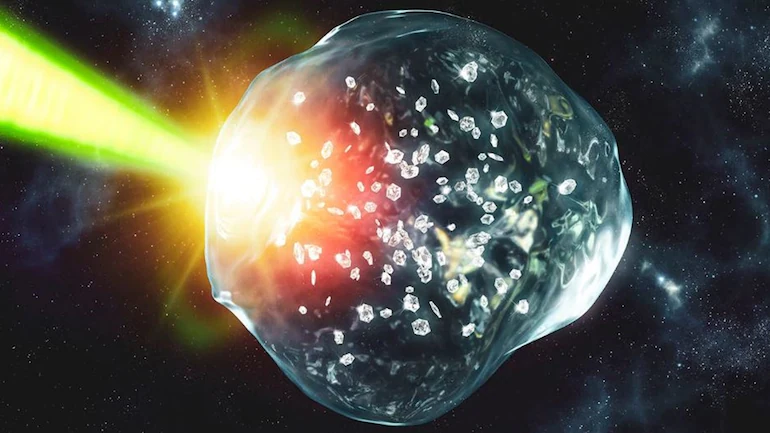Little is known about ice giants Uranus and Neptune, the two most distant planets in our Solar System.
Scientists speculate that diamond rain may be falling on planets throughout the universe after simulating the odd precipitation thought to originate deep inside Uranus and Neptune using everyday plastic.
The discovery might reveal a new method for creating nanodiamonds, which have a growing number of uses, such as medicine administration, medical censors, less invasive surgery, and quantum electronics.
Scientists had previously postulated that thousands of kilometres beneath the surface of the ice giants, under conditions of great pressure and temperature, carbon and hydrogen are transformed into solid diamonds.
Now, new research, published in Science Advances, added oxygen to the mix and discovered that “diamond rain” may occur more frequently than previously believed.
Since ice giants like Neptune and Uranus are believed to be the most prevalent type of planet outside of our Solar System, diamond rain may be present across the cosmos.
One of the study’s authors, Dominik Kraus, a physicist at the German HZDR research facility, noted that diamond precipitation was very dissimilar from rain on Earth.
The diamonds are thought to originate in a “hot, dense liquid” beneath the planets’ surfaces, where they gradually descend to the rocky, potentially Earth-sized cores more than 10,000 kilometres below.
According to Kraus, the diamonds that have fallen there may have formed huge layers that extend “hundreds of kilometres or even more.”
He said that although these diamonds might not be polished and cut like “a nice gem on a ring,” they were created by the same forces that exist on Earth.
In an effort to duplicate the process, the study team discovered the right proportion of carbon, hydrogen, and oxygen in PET plastic, which is commonly used for bottles and ordinary food packaging.
Kraus stated that even though the researchers used PET plastic that was extremely clean, “the experiment should work with Coca-Cola bottles” in principle.
At the SLAC National Accelerator Laboratory in California, the scientists next used a strong optical laser to cut through the plastic.
They were able to observe the formation of nanodiamonds—tiny diamonds too small to be seen with the naked eye—using “very, very short X-ray flashes of incredible brightness.”
Since little is known about Uranus and Neptune, the two most distant planets in our Solar System, the diamond rain research is still purely theoretical.
Only one spacecraft, NASA’s Voyager 2, has passed by the two ice giants, and the information it returned is still used in science today.
However, a NASA team has proposed a brand-new expedition to the planets that may go off in the coming decade.







